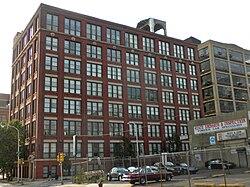
Manayunk is a neighborhood in the section of Lower Northwest Philadelphia in the state of Pennsylvania. Located adjacent to the neighborhoods of Roxborough and Wissahickon and also on the banks of the Schuylkill River, Manayunk contains the first canal begun in the United States.

Northern Liberties is a neighborhood in Philadelphia, Pennsylvania, United States. Prior to its incorporation into Philadelphia in 1854, it was among the top 10 largest cities in the U.S. in every census from 1790 to 1850.

Callowhill is one of the unofficial names for a neighborhood in Philadelphia, Pennsylvania, United States, located roughly in the vicinity of Callowhill Street, between Vine Street, Spring Garden Street, Broad Street, and 8th Street. The name "Callowhill" was coined by the Callowhill Neighborhood Association, a community organization in the area; although this name often appears on online maps, the City of Philadelphia does not have an official name for this area. Callowhill is named for Callowhill Street, which was named after Hannah Callowhill Penn, William Penn's second wife.

The New Amsterdam Historic District is a historic district located in Detroit, Michigan. Buildings in this district are on or near three sequential east-west streets on the two blocks between Woodward Avenue and Second Avenue. It was listed on the National Register of Historic Places in 2001.
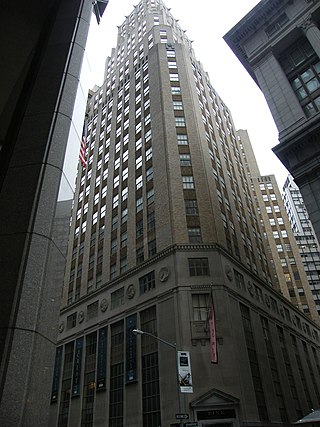
63 Wall Street, originally the Wall and Hanover Building, is a 37-story skyscraper on Wall Street in the Financial District of Manhattan in New York City. Built in 1929, it was designed by Delano & Aldrich as the headquarters of Brown Brothers & Co.
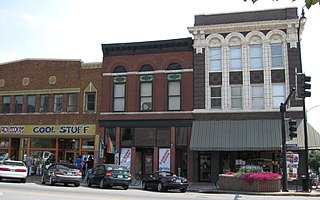
The Eighth and Broadway Historic District is one of the seven national historic districts located in Columbia, Missouri. The district is made up of three contributing properties and is located at the intersection of Eighth and Broadway Streets in Downtown Columbia. They consist of the Beaux-Arts style Miller Building (1910), the Italianate style Matthews Hardware, and the Art Deco style Metropolitan Building. Today, the area holds loft apartments and several local business including Rally House, Sycamore, Peace Nook, and Geisha.

The Crescent Warehouse Historic District is a 10.5-acre (4.2 ha) historic district in Downtown Davenport, Iowa, United States. The district is a collection of multi-story brick structures that formerly housed warehouses and factories. Most of the buildings have been converted into loft apartments. The district was listed on the National Register of Historic Places in 2003.

The H. J. Heinz Company complex, part of which is currently known as Heinz Lofts, is a historic industrial complex in the Troy Hill neighborhood of Pittsburgh, Pennsylvania. The buildings were built by the H. J. Heinz Company from 1907 through 1958. The complex is listed on the National Register of Historic Places (NRHP) and five of the buildings are listed as a Pittsburgh History and Landmarks Foundation Historic Landmark.

The River Street Historic District is a national historic district that is located in Wilkes-Barre, Pennsylvania.

The New Kensington Downtown Historic District, also known as the New Kensington Commercial and Residential Historic District, is a national historic district that is located in New Kensington, Westmoreland County, Pennsylvania.
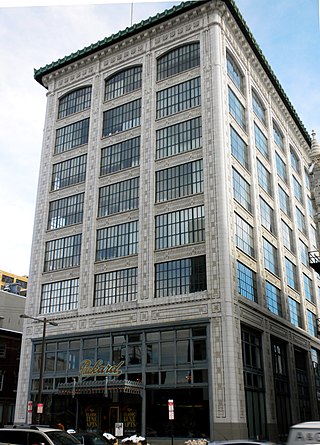
The Packard Motor Car Company Building, also known as the Press Building, is an historic, American office building that is located at 317–321 North Broad Street between Pearl and Wood Streets in the Callowhill neighborhood of Philadelphia, Pennsylvania.
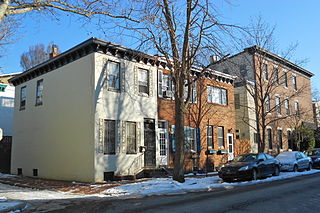
The Ramcat Historic District, also known as the Schuylkill Historic District, is a national historic district that is located in the Rittenhouse Square West neighborhood of Philadelphia, Pennsylvania.

The General Electric Switchgear Plant is a historic factory building located at 421 North 7th Street at Willow Street in the Callowhill neighborhood of Philadelphia, Pennsylvania. It was built in 1916, and is a seven-story, seven bay by nine bay, reinforced concrete building with brick facing. It was designed by William Steele & Company for General Electric, which manufactured electric switchboard equipment there.

The Smaltz Building, also known as the Smaltz-Goodwin Building, is an historic, American factory building that is located in the Callowhill neighborhood of Philadelphia, Pennsylvania.

The terminal Terminal Commerce Building, also known as the North American Building, is an historic, American building complex that is located in the Callowhill neighborhood of Philadelphia, Pennsylvania.

Washington Avenue Historic District, or Washington Avenue Factory District, is a national historic district located in the Hawthorne and Bella Vista neighborhoods of South Philadelphia, Pennsylvania. It comprises the remaining four blocks of one of the last industrial neighborhoods in Philadelphia, and encompasses eight contributing buildings built between 1889 and 1927:

The Girard Avenue Historic District is a national historic district which is located in the Cabot neighborhood of Philadelphia, Pennsylvania, United States.

Callowhill Industrial Historic District is a national historic district located in the Callowhill neighborhood of Philadelphia, Pennsylvania. It encompasses 31 contributing buildings, 1 contributing site, and 1 contributing structure. The commercial and industrial buildings were mostly built from the 1890s through the 1930s. They range from 4 to 14 stories in height and the exteriors are of brick, concrete, terra cotta, and stone. Most of the buildings are characterized as box-shaped, mid-rise loft buildings with flat roofs. Also in the district are eleven 2+1⁄2-story brick rowhouses, with the earliest dated to the 1830s. Notable buildings include the Rebman Building (1903), Stewart Cracker Building, U.S. Tire Company Building (1911), Lasher Building (1927), Philadelphia City Morgue (1928), and Overland Motor Company Building. Located in the district and listed separately are the Smaltz Building (1912), Terminal Commerce Building, Goodman Brothers and Hinlein Company, and the Packard Motor Corporation Building.

The Fifteenth Street Financial Historic District is a historic district in Washington, D.C. that was listed on the National Register of Historic Places in 2006, and modified to the Financial Historic District in 2017. It includes works of Beaux Arts and other architecture by several architects, in 20 contributing buildings built between 1835 and 1940. This building is a linear district of monumental Beaux Arts Classicist commercial buildings notable both individually and as an extraordinarily cohesive ensemble.

The Palmerton Historic District is a national historic district located in Palmerton, Carbon County, Pennsylvania. Bordered roughly by Tomb Street, Avenue A, 8th Street, and Harvard Avenue, it encompasses 1,262 contributing buildings, seven contributing structures, and four contributing sites, as well as 475 noncontributing buildings and 13 noncontributing sites where previously demolished resources had been located. Usage functions range from commercial and industrial to institutional to residential in nature. This district was added to the National Register of Historic Places on January 19, 2018 in recognition of its significance in community planning and development.
